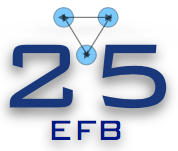Conveners
Tuesday Parallel Session: AMO Systems (Linke Aula)
- Mario Gattobigio (Université Côte d'Azur - Institut de Physique de Nice)
Discrete scale symmetry exhibited by few-particle systems for resonant s-wave interactions is affected by squeezing or by reducing the embedding dimension. The Efimov geometrical separation ratio between the AAB bosonic bound states energies increases as the system is squeezed until the geometrical spectrum disappears for a critical non-integer dimension. This is found either by solving the ...
In the framework of the effective mass approximation and assuming a logarithmic interaction between constituent charged particles, compact and locally accurate wave functions that describe bound states of the two-particle neutral and three-particle charged complexes in two dimensions are designed. Prime examples of these complexes are excitons and trions that appear in monolayers of...
A gas of interacting particles is a paradigmatic example of chaotic systems. It is shown [1] that, even if all but one particle are fixed in generic positions, the excited states of the moving particle are chaotic. They are characterized by the number of principal components (NPC)—the number of integrable system eigenstates involved into the nonintegrable one, which increases linearly with the...
Resonances in open quantum systems have been actively studied since the very birth of quantum mechanics [1,2]. Their linewidth broadenings caused by the finite lifetimes can be analytically estimated only in a few particular cases [3]. In this sense, the analytically estimated linewidth broadenings of the electron-impurity resonant states by Monozon and Schmelcher [4] is a remarkable...
Three-body recombination between helium and silver atoms is studied using hyperspherical coordinates. The three-body Schrodinger equation, represented in the slow variable discretized approach at short distances and in the adiabatic method at large distances [1] and using the potential-energy surface represented as the addition of realistic He-He and He-Ag pair interaction potentials [2][3],...

